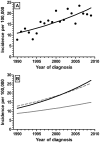Increasing incidence and age at diagnosis among children with type 1 diabetes mellitus over a 20-year period in Auckland (New Zealand)
- PMID: 22389717
- PMCID: PMC3289670
- DOI: 10.1371/journal.pone.0032640
Increasing incidence and age at diagnosis among children with type 1 diabetes mellitus over a 20-year period in Auckland (New Zealand)
Abstract
Background: We aimed to evaluate the incidence of type 1 diabetes mellitus in children <15 years of age (yr) in the Auckland region (New Zealand) over 20 years (1990-2009).
Methods: We performed a retrospective review of all patients <15 yr diagnosed with type 1 diabetes, from an unselected complete regional cohort.
Results: There were 884 new cases of type 1 diabetes, and age at diagnosis rose from 7.6 yr in 1990/1 to 8.9 yr in 2008/9 (r(2) = 0.31, p = 0.009). There was a progressive increase in type 1 diabetes incidence among children <15 yr (p<0.0001), reaching 22.5 per 100,000 in 2009. However, the rise in incidence did not occur evenly among age groups, being 2.5-fold higher in older children (10-14 yr) than in the youngest group (0-4 yr). The incidence of new cases of type 1 diabetes was highest in New Zealand Europeans throughout the study period in all age groups (p<0.0001), but the rate of increase was similar in New Zealand Europeans and Non-Europeans. Type 1 diabetes incidence and average annual increase were similar in both sexes. There was no change in BMI SDS shortly after diagnosis, and no association between BMI SDS and age at diagnosis.
Conclusions: There has been a steady increase in type 1 diabetes incidence among children <15 yr in Auckland over 20 years. Contrary to other studies, age at diagnosis has increased and the greatest rise in incidence occurred in children 10-14 yr. There was little change in BMI SDS in this population, providing no support for the 'accelerator hypothesis'.
Conflict of interest statement
Figures


Similar articles
-
The incidence, clinical features, and treatment of type 2 diabetes in children <15 yr in a population-based cohort from Auckland, New Zealand, 1995–2007.Pediatr Diabetes. 2012 Jun;13(4):294-300. doi: 10.1111/j.1399-5448.2012.00851.x. Pediatr Diabetes. 2012. PMID: 22646236
-
Evidence of a plateau in the incidence of type 1 diabetes in children 0-4 years of age from a regional pediatric diabetes center; Auckland, New Zealand: 1977-2019.Pediatr Diabetes. 2021 Sep;22(6):854-860. doi: 10.1111/pedi.13236. Epub 2021 Jun 4. Pediatr Diabetes. 2021. PMID: 34018288
-
15-year incidence of diabetic ketoacidosis at onset of type 1 diabetes in children from a regional setting (Auckland, New Zealand).Sci Rep. 2015 May 19;5:10358. doi: 10.1038/srep10358. Sci Rep. 2015. PMID: 25989414 Free PMC article.
-
["Constantly rising or peaks and plateaus?" Incidence of childhood type 1 diabetes in Hungary (1989-2009)].Orv Hetil. 2011 Oct 16;152(42):1692-7. doi: 10.1556/OH.2011.29210. Orv Hetil. 2011. PMID: 21979222 Review. Hungarian.
-
Epidemiology of type 1 (insulin-dependent) and type 2 (non-insulin-dependent) diabetes mellitus in Japanese children.Diabetes Res Clin Pract. 1994 Oct;24 Suppl:S7-13. doi: 10.1016/0168-8227(94)90221-6. Diabetes Res Clin Pract. 1994. PMID: 7859637 Review.
Cited by
-
Emerging Approaches in Surveillance of Type 1 Diabetes.Curr Diab Rep. 2018 Jul 11;18(9):61. doi: 10.1007/s11892-018-1033-1. Curr Diab Rep. 2018. PMID: 29995215 Free PMC article. Review.
-
Increased Incidence of Type 1 Diabetes in Children and No Change in the Age of Diagnosis and BMI-SDS at the Onset - is the Accelerator Hypothesis not Working?J Clin Res Pediatr Endocrinol. 2020 Sep 2;12(3):281-286. doi: 10.4274/jcrpe.galenos.2020.2019.0133. Epub 2020 Jan 28. J Clin Res Pediatr Endocrinol. 2020. PMID: 31990164 Free PMC article.
-
Ethnic differences in association of high body mass index with early onset of Type 1 diabetes - Arab ethnicity as case study.PLoS One. 2017 Apr 13;12(4):e0175728. doi: 10.1371/journal.pone.0175728. eCollection 2017. PLoS One. 2017. PMID: 28406962 Free PMC article.
-
Is the risk and nature of CVD the same in type 1 and type 2 diabetes?Curr Diab Rep. 2013 Jun;13(3):350-61. doi: 10.1007/s11892-013-0380-1. Curr Diab Rep. 2013. PMID: 23519720 Free PMC article. Review.
-
The Use of Mobile Health to Deliver Self-Management Support to Young People With Type 1 Diabetes: A Cross-Sectional Survey.JMIR Diabetes. 2017 Feb 15;2(1):e4. doi: 10.2196/diabetes.7221. JMIR Diabetes. 2017. PMID: 30291057 Free PMC article.
References
-
- The Diamond Project Group. Incidence and trends of childhood Type 1 diabetes worldwide 1990–1999. Diabetic Med. 2006;23:857–866. - PubMed
-
- Onkamo P, Väänänen S, Karvonen M, Tuomilehto J. Worldwide increase in incidence of Type I diabetes – the analysis of the data on published incidence trends. Diabetologia. 1999;42:1395–1403. - PubMed
-
- Patterson CC, Dahlquist GG, Gyürüs E, Green A, Soltész G. Incidence trends for childhood type 1 diabetes in Europe during 1989–2003 and predicted new cases 2005–20: a multicentre prospective registration study. Lancet. 2009;373:2027–2033. - PubMed
-
- Harjutsalo V, Sjöberg L, Tuomilehto J. Time trends in the incidence of type 1 diabetes in Finnish children: a cohort study. Lancet. 2008;371:1777–1782. - PubMed
-
- Sella T, Shoshan A, Goren I, Shalev V, Blumenfeld O, et al. A retrospective study of the incidence of diagnosed Type 1 diabetes among children and adolescents in a large health organization in Israel, 2000–2008. Diabetic Med. 2011;28:48–53. - PubMed
MeSH terms
LinkOut - more resources
Full Text Sources
Medical

